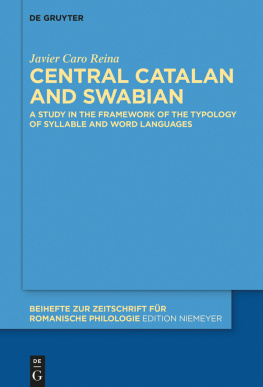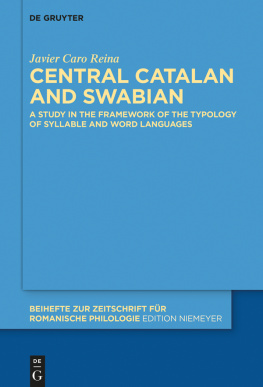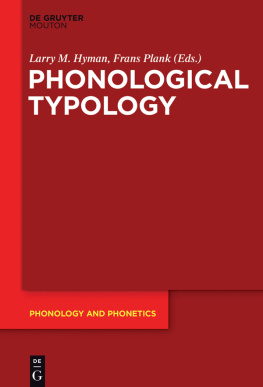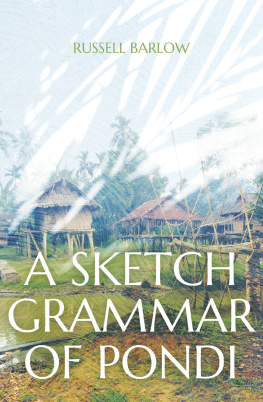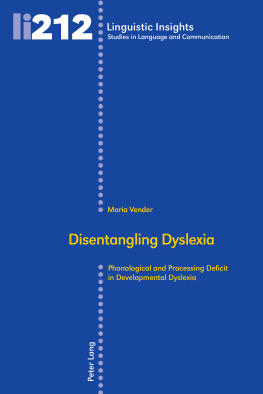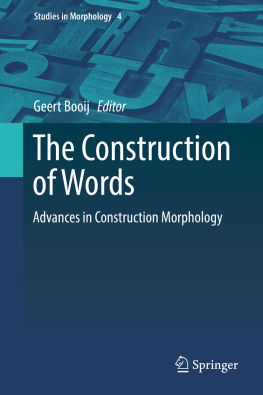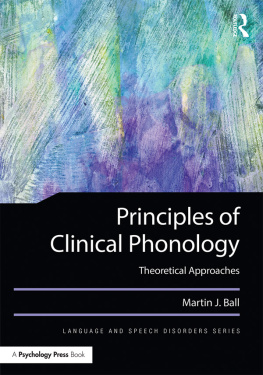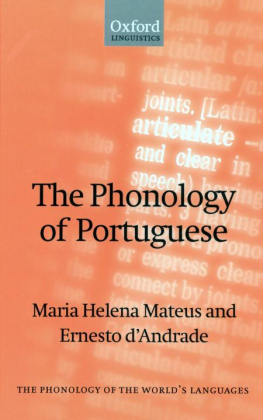Contents
Guide

Empirical Approaches to the Phonological Structure of Words
Linguistische Arbeiten

Edited by
Klaus von Heusinger, Gereon Mller,
Ingo Plag, Beatrice Primus,
Elisabeth Stark and Richard Wiese
Volume 567

ISBN 978-3-11-054058-1
e-ISBN (PDF) 978-3-11-054289-9
e-ISBN (EPUB) 978-3-11-054064-2
ISSN 0344-6727
Library of Congress Cataloging-in-Publication Data
A CIP catalog record for this book has been applied for at the Library of Congress.
Bibliographic information published by the Deutsche Nationalbibliothek
The Deutsche Nationalbibliothek lists this publication in the Deutsche Nationalbibliografie;
detailed bibliographic data are available on the Internet at http://dnb.dnb.de.
2018 Walter de Gruyter GmbH, Berlin/Boston
www.degruyter.com
Christiane Ulbrich, Alexander Werth, and Richard Wiese
The word in phonology: questions and answers
Introduction
In the history of linguistics, the notion of the word is a slippery one. Attempts at defining the word as a basic concept go back to the Greek grammarians such as Dionysios Thrax, but have never been completed or been satisfactory in all respects, as many definitions proposed are imprecise, contradictory or circular. Nevertheless, the word has remained a central concept in linguistic description and theory. One promising approach to the problem of defining the word in linguistics is to recognize that the word is not a single category, but one relevant to all major levels of linguistic description, and that it should thus be defined and studied with reference to each of these levels. This approach has at least the advantage of making the problem more manageable. In other words, we may postulate that there is a word in the sense of a morphological word, a syntactic word, a phonological word, a graphematic word, a lexeme (the set of word forms in a paradigm), and a semantic word. At the same time, the word is a unified concept, as it is a sign in the Saussurean sense, and therefore encompasses a level of form and a level of meaning.
All of these level-specific words mentioned above have been discussed, sometimes thoroughly, sometimes only cursorily; see, e.g., Julien (2006) on different notions of the word, Dixon and Aikhenvald (2002) on typological aspects, Gallmann (1999) on the graphematic word, Wurzel (2000) on the morphological word, and Hall and Kleinhenz (1999) on the phonological word. One initial crucial key factor relevant to for the distinction made between the word notions on the various linguistic levels derives from the fact that the different types of words are not in a one-to-one relationship. Consider so-called particle verbs such as break up in English or aufhren (to stop) in German. Semantically, they are lexical units, but syntactically, they consist of two independent items occurring in different syntactic positions, as seen in break it up or hrte damit auf (stopped it). Analogously, compounds in their entirety are seen as morphological or lexical units, while their component parts have been argued to form phonological words on their own (Wiese 1996: 7274). The same is true at least for some morphologically derived words, which presumably have a different phonological status depending on the respective language (see below ). Again, words on different levels are non-isomorphic to each other. Such non-isomorphies are the basis of one line of argument for the separation of word notions on different, but systematically related, levels. A second line of argument for the separation of words stems from the fact that these word notions follow their own constraints and principles. We will pursue the latter in the following considering the word from a phonological point of view.
The word in phonology
2. Properties of the Phonological Word
The Phonological Word (PW) or alternatively the Prosodic Word can be defined, in first approximation, as a particular unit in the prosodic hierarchy. The PW is to be located within such a hierarchy between the lower unit of the foot and the higher unit of the Phonological Phrase (at least as far as the theoretical approach does not consider the Clitic Group as the unit immediately above the PW). This conception was most clearly postulated by Nespor and Vogel ([1986] 2007). They conceive this hierarchy as ranging from the syllable or the mora up to the Utterance. In contrast to most other prosodic units considered in the pertinent literature, the PW is defined with reference to morphological units by means of mapping rules: some types of morphemes form a PW of their own, while other types do not. The other such unit is the Phonological Phrase, which may be defined with reference to syntactic phrases.
The PW will turn out to be a useful, even necessary, category to the extent that it is needed as a domain that allows for an adequate explanation of various segmental, suprasegmental and phonotactic generalizations in the worlds languages. For German, for example, Wiese (1996) and others argues that stems, prefixes and suffixes beginning with a consonant (e.g. -heit or -lich ) correspond to an individual PW, while suffixes beginning with a vowel (e.g. -ung or -ier ) or consisting of a single consonant (e.g. -t , -s ) do not. Languages may vary in this respect; Booij (1984, 1999) argues that vowel harmony in Hungarian applies within the domain of the PW, and shows that all suffixes combine with the preceding stem in order to form the relevant PW domain for vowel harmony. Furthermore, the PW may provide the domain for the process of syllabification, a process related to phonotactic constraints such as the concatenation of consonants into word-initial and/or word-final clusters (cf. Raffelsiefen 2000; Wurzel 2000). The synchronization of segmental and suprasegmental units as well as temporal effects such as pausing, lengthening etc. is also applicable to the PW (cf. e.g. Prieto, Estebas-Vilaplana and del Mar Vanrell 2010 for F0-alignment in Catalan).
In addition, there are further processes identified in past research, including matters of stress assignment (one main stress per PW), assimilation, and dissimilation such as German nasal assimilation and degemination that appear to apply within the domain of the PW (cf. Wiese 1996). However, they have not satisfactorily been evidenced as diagnostic tools for the universal status of the PW (cf. Hall 1999: 1719). More specifically, Dixon and Aikhenvald (2002: 13) state: [i]t is clear that there is no single criterion which can serve to define a unit phonological word in every language. Rather there is a range of types of criteria such that every language that has a unit phonological word (which is probably every language in the world) utilises a selection of these. Therefore, the discussion of the PW is not over, and there is clearly a need for extended empirical studies.
2. Boundaries and constituent parts of the Phonological Word
For the larger part of the history of phonology, the word, as a phonological object, was simply regarded as a linear sequence of phonemes. However, most researchers regardless of their respective framework will now agree that this is grossly over-simplified. The range of phonological categories below the PW encompasses at least the following: foot, syllable, syllable constituents (onset, rhyme, coda), and mora. The shape of phonological words is largely determined by universal and language-specific preferences in terms of these sub-constituents.


